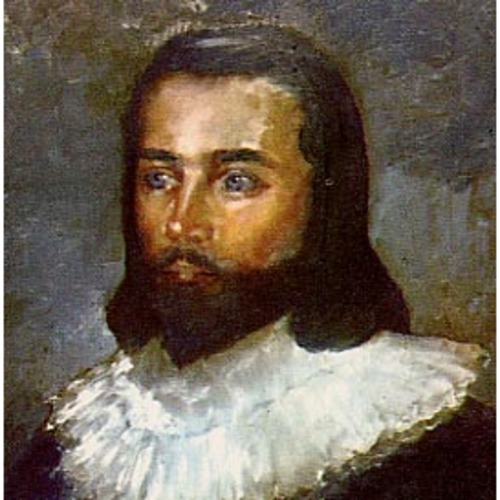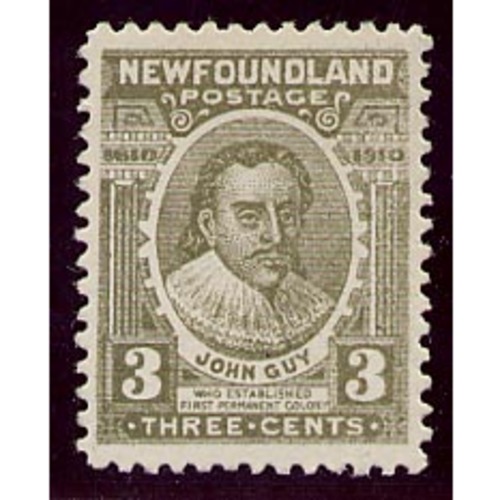
Source: Link
GUY, JOHN, colonizer, explorer, governor of the first English colony in Newfoundland; d. c. March 1629.
From the beginning of the 17th century John Guy was prominent in the civic and commercial life of Bristol. In 1603 he was elected to the Common Council on which he served until 1629; he was also a member of the Bristol Society of Merchant Venturers. In 1606, when sheriff of the city, he and the mayor, Thomas James (the father of Capt. Thomas James), became the principal Bristol subscribers to the North Virginia Company. Four years later he was appointed governor of the colony to be established in Newfoundland by the London and Bristol company.
It is possible that Guy was the originator of this movement to colonize Newfoundland. In 1608 he had visited the island and the following year, according to Purchas, he wrote a tract – of which no copy is known – advocating the settlement of Newfoundland. Early in 1610 a petition for a grant of incorporation was submitted to the Privy Council by John Slany, treasurer of the company, and John Guy, as representatives of the two groups of subscribers from London and Bristol. By its charter, scaled in May 1610, the company was granted the whole island, with particular emphasis on the area of the Avalon peninsula. Before leaving, Guy received detailed instructions as to the employment of his men and the requirements of a good site. Elaborate provision was also made for the government of the colony: Guy had supreme authority and was to govern without assistance; if he died without naming a successor, his brother Philip, who was also a subscriber to the company, was to be governor. In the event of Philip’s death, William Chatchmaid was to succeed.
On 5 July 1610, John and Philip Guy and the other colonists, including Colston and probably Rowley, sailed from Bristol, reaching Newfoundland in August. The actual choice of site was entrusted to John and, on arrival, he decided on Cuper’s Cove (now Cupids) rather than on Colliers Cove, also in Conception Bay. Much of our knowledge of the settlement’s early history comes from Guy’s letters home, which reveal his preoccupation with making the colony self-supporting. From the outset the planters’ industry was remarkable and a tribute to Guy’s leadership, which always seems to have been well accepted by his men. The first winter was mild: of the 39 settlers, only 4 died. Their time was occupied in building and fortifying their habitation, in exploring and farming.
Guy returned to England in the late summer of 1611; he was at this time treasurer of the Merchant Venturers. Before leaving, he issued orders for the regulation of the fishery, to reform the disorderly practices of the visiting fishermen and placed his brother, Philip, and William Colston in charge of the colony. Early in 1612 he returned to the island, bringing more colonists.
That summer was a difficult time for Guy because of the raids of the pirate, Peter Easton. The fishermen ignored Guy’s advice to attack the pirate and so suffered heavily. Guy himself was with Easton for 14 days and seems to have won immunity for the colony; there was only one incident when a colonist was shot in error. However, Easton’s visit forced Guy to abandon the company’s plan to establish a settlement at Renewse that year. He withdrew his men and concentrated on strengthening Cuper’s Cove.
Also hindered was the journey of exploration to Trinity Bay, which Guy had intended that summer. Not until October did he set out with 18 men, including Pearson, and 2 boats. He explored Trinity Bay with some care, looking vainly for a passage to Placentia Bay, but his main purpose was to establish contact with the Beothuk Indians, which he did at Bull Arm. George Whittington, one of the colonists, was chosen to go ashore first to convince the Indians that they came in friendship. Guy’s journal of the expedition gives a charming account of the encounter, the exchange of gifts, and the shared meal. Some furs were obtained and, after an eventful journey, Guy regained Cuper’s Cove late in November. That winter was the most severe yet experienced; 22 of the 62 settlers suffered from scurvy, though only 8 died. In April 1613 Guy suddenly left for England and the expedition which he had intended to lead that summer was abandoned.
It was expected that Guy would return in the autumn of 1613, but in September he was still in Bristol. Probably he did go to Newfoundland early in 1614 but stayed only for the summer, since in December 1614 he was again in Bristol. At this time his relations with the company became strained and Guy complained bitterly of their treatment of himself and the other colonists: he had not received the land promised him nor had the men received their wages. A letter which he wrote in 1614 strongly suggests that his dispute with the company had gone to law (Middleton MSS, Mi X 1/28); however his land must have been allotted to him by 1626, when he bequeathed it to his sons. In 1616 John Slany accused Guy of having deceived the company over the island’s mineral resources. About this time John Mason was appointed governor of the colony.
Probably Guy never returned to Newfoundland but he had left the colony firmly established with over 60 inhabitants, both men and women. Cargoes of fish and merchantable timber which would help towards the cost of the enterprise had been sent home; new areas of a little-known country had been explored; a fur trade with the Indians had been begun. By comparison with the careers of the first governors of other such ventures, Guy’s had been most successful.
He took up life in Bristol with renewed vigour; in 1618 he served as mayor and, the following year, became an alderman. From December 1620 until 1622, he represented Bristol in the House of Commons and was particularly prominent in the long debates on the bill for the greater liberty of fishing voyages to North America. Guy consistently opposed the bill as jeopardizing the freedom of the Newfoundland planters in the fishery. In September 1621 he represented Bristol in the government inquiry into the decline of trade. He was master of the Merchant Venturers in 1622 and in 1624 he was returned to Parliament for a further year when he again supported the Newfoundland planters in the renewed debate on the fishery.
In February 1626 Guy made a will bequeathing extensive property to his seven children and his wife, Anne; his Seaforest estate in Newfoundland he divided among three of his sons. He attended his last meeting of the Common Council in June 1628, and in May 1629, probate was granted to his wife. A monument was later erected to his memory in St. Stephen’s Church, Bristol.
There are letters from John and Nicholas Guy, and papers relating to them, at Nottingham University, Middleton MSS, Mi X 1/1–66. John Guy’s journal is at Lambeth Palace, MS 250 ff.406–12 are reproduced in The New World: a catalogue of an exhibition of books, maps, manuscripts and documents held at Lambeth Palace library between 1 May and 1 December 1957 (London, 1957), 52–64). His will is at Somerset House, P.C.C., 48 Ridley. Other sources are: PRO, C.O. 1/1. Trinity House, Trans., 1609–25. Proceedings and debates of the British Parliaments respecting North America, ed. L. F. Stock (5v., Washington, 1924–41), I. Purchas, Pilgrimes (1905–7), XIX. A. B. Beaven, Bristol lists (Bristol, 1889). John Latimer, The history of the Society of Merchant Venturers of the city of Bristol (Bristol, 1903). J. W. Damer Powell, “John Guy: founder of Newfoundland,” United Empire, XXIV (1933), 323–27.
Cite This Article
Gillian T. Cell, “GUY, JOHN,” in Dictionary of Canadian Biography, vol. 1, University of Toronto/Université Laval, 2003–, accessed December 25, 2025, https://www.biographi.ca/en/bio/guy_john_1E.html.
The citation above shows the format for footnotes and endnotes according to the Chicago manual of style (16th edition). Information to be used in other citation formats:
| Permalink: | https://www.biographi.ca/en/bio/guy_john_1E.html |
| Author of Article: | Gillian T. Cell |
| Title of Article: | GUY, JOHN |
| Publication Name: | Dictionary of Canadian Biography, vol. 1 |
| Publisher: | University of Toronto/Université Laval |
| Year of publication: | 1966 |
| Year of revision: | 1979 |
| Access Date: | December 25, 2025 |




